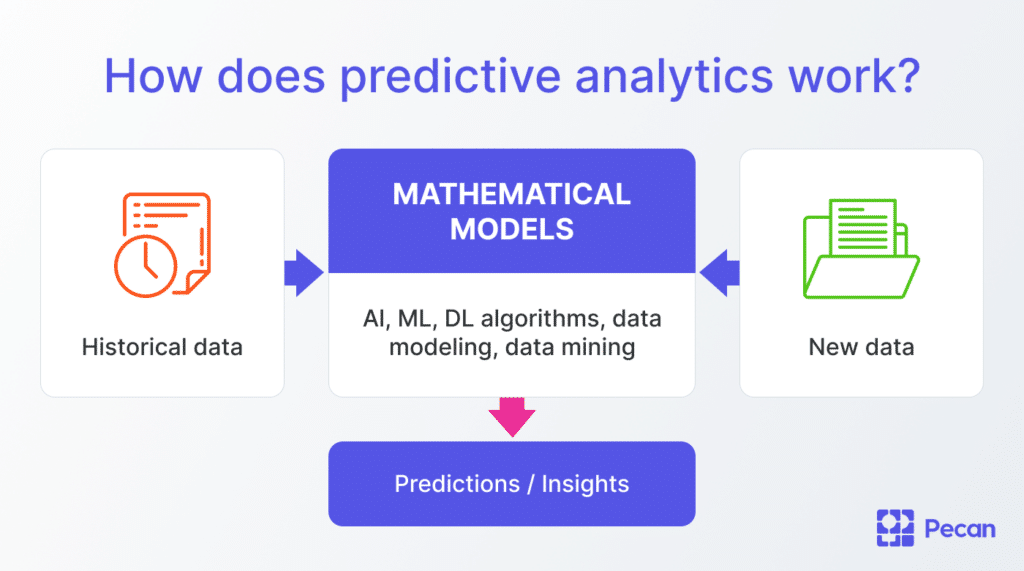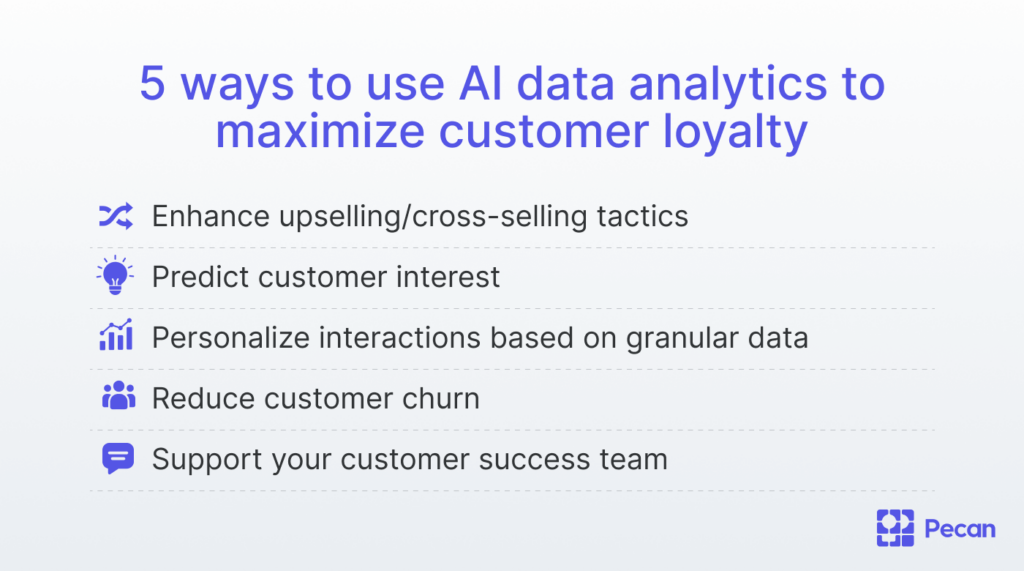AI data analytics have changed the landscape for customer acquisition. For all its revenue-boosting qualities, acquiring new customers continues to be costly. Paid ads, outreach, using historical data to predict behavior, the time required to draw consumers into the sales funnel — it’s a lot.
The next step is to keep those customers from leaving — loyal customers can provide much more revenue in the long run. That’s why you need to invest in a data-driven customer loyalty campaign to improve customer retention.
This article will delve into what customer loyalty is when it’s broken down into key performance indicators. Then, we’ll show how AI data analytics can help you proactively nurture loyal, satisfied customers.
What is customer loyalty?
Customer loyalty has an elite ring to it — the way it's spoken about, it almost sounds like each brand has a group of dedicated followers. The truth is that it’s the natural pattern of humans to seek out what's familiar. This inclination remains when we choose the brands we shop from regularly. In fact, customer loyalty has become a major priority for businesses.
To see why, let’s break customer loyalty down. Customer loyalty is a measure of frequent customer interaction with and purchases from your brand. As their positive experiences increase, so does their sense of loyalty. This means customers will consistently choose your brand over your competitors.
Naturally, there must be good reasons for customers to be loyal to your brand — quality services, good value, and customer satisfaction. The boom in brand membership programs in the past couple of years highlights how important customer loyalty is for businesses today.
Why is customer loyalty important?
In the past, consumers were loyal to businesses close to them, like the corner shop, the bakery down the street, or the grocer on the next block. They didn’t have much choice but to regularly buy from familiar brands. These days, the choices are endless. With location no longer a barrier, tons of brands are available, making customer loyalty a rare, valuable thing.
Initially, this might not seem like a huge problem. Any business, small or large, can get clients and customers. So investing in customer acquisition — in marketing and sales — is essential to getting a piece of the market share. But a master angler who releases their catch hasn’t technically caught anything.
A brand should keep its customers hooked, even after securing the first deal, as that will generate much more growth from longtime customers. A high Net Promoter Score (one measure of customer loyalty) results in 2.5 times faster revenue growth than competitors in the same industry.
Longtime customers are more likely to:
- Make repeat purchases: If you invest in customer loyalty, you get higher profits from customers who buy products or services from you repeatedly. Plus, you can reduce (or at least offset) some of the customer acquisition costs.
- Promote your brand through word-of-mouth: A person dedicated to buying from the same brand is naturally going to recommend that brand to others. While organic and out of your control, word-of-mouth marketing may more easily inspire loyal customers.
- Pay more for premium products and services: When you have a customer who trusts your brand, they are your go-to audience, your first line of leads to persuade to try out additional, greater value items or services. For example, Costco members don’t mind the membership cost because they know Costco’s wholesale prices are cheaper in the long run. Similarly, fans of authoritative luxury skincare brands like La Roche-Posay won’t mind paying more for a special product bundle (even if they wouldn’t have otherwise purchased each product separately).
All this being said, customer loyalty can seem like a vague concept that’s hard to grasp and measure. How can we improve something so subjective as how trustworthy and satisfactory a customer finds us?
How can AI data analytics improve customer loyalty?
What are your next steps in capturing the key, data-driven actions that drive custom loyalty? You need an efficient, accurate way to process the metrics indicative of customer loyalty. It all starts with artificial intelligence-based data analytics. Many businesses already try to do this with traditional business intelligence, but simply analyzing the data isn’t enough — you need to go a step further to adopt AI and predictive approaches.
What is AI data analytics?
With the power of artificial intelligence, you can process robust datasets and distill them into meaningful information. AI data analytics platforms like Pecan AI go further by providing predictive analysis. With predictive analysis rather than traditional business intelligence, you can look at specific customer behaviors, use those insights to implement advanced customer engagement, and analyze those metrics to improve that engagement.
What might a customer’s behavior look like tomorrow, next week, or next month? More importantly, what can you do to engage that customer at decisive moments — and win their loyalty in the long term? These are questions you can only address with AI data analytics rather than traditional analytics, as you can then see in advance when a customer’s loyalty might be flagging.
According to a 2022 study, the following are the top four drivers of leading brand loyalty:
- A plentiful range of product options
- Product availability
- Data privacy policies
- Good customer service
These drivers have a lot to do with AI data analytics. Instead of just analyzing data from your customers’ past activity, you can use that data to make predictions that help you give customers the right product options, ensure their favorite products are in stock, and improve their personalization during customer service experiences. And importantly, you can do all this while ensuring their data is protected.
AI data analytics platforms can not only auto-calculate various metrics and quantifiable outcomes that factor into customer loyalty, they can predict these outcomes, too:
- Customer retention
- Customer churn
- Customer lifetime value
- Repeat-purchase rate
- Upsell likelihood
This allows you to manage, track, predict, and iterate multiple campaigns at once. An AI data analytics tool takes things further by providing accurate next steps to profoundly impact these metrics and, as a whole, customer loyalty.
Why use AI data analytics to improve customer loyalty?
In a nutshell, AI data analytics boost customer loyalty by empowering you to…
- Be proactive rather than reactive: Rather than waiting until an issue arises to fix, AI data analytics lets you keep an eye on potential problems with suggestions to prevent them.
- Be predictive, not just descriptive: In a world where profiling is seen as a successful mode of making informed decisions, predictive analytics is the next evolutionary step. AI predicts potential outcomes with your customer and transaction data.
- Reduce costs and maximize resources: Predictions from AI data analytics ensure you avoid the costs of losing customers, missing out on conversions, or expensive ads that go nowhere.
4 ways to use AI data analytics to maximize customer loyalty
With AI data analytics, you can essentially predict the who, what, and when of each conversion.
- WHO: Identify who of your customers are likely to make repeat purchases.
- WHAT: Determine which products or services each customer will likely buy next.
- WHEN: Accurately estimate when your customers will likely make another purchase.
This three-point predictive analysis drives the following ways you can use AI data analytics to boost loyalty.
1. Predict customer interests
AI data analytics can help you predict your customers’ interests based on vast behavior datasets. Predictive analytics uses purchase history, browsing data, feedback, and more to predict whether a customer might be interested in purchasing more or upgraded products or services. This way, you can offer discounts or rewards at the right time.
Perhaps more importantly, you can use AI data analytics predictive technology to highlight which products will likely be next on a customer’s order and improve your cross-selling strategy. Out of 500 sales professionals, 72% who upsell and 74% who cross-sell report that their efforts result in up to 30% of their revenue. This is a huge well of opportunity to maximize growth. An AI data analytics tool, like Pecan AI, identifies customers likely to buy complementary or premium products and services.
Key tip: Leverage predictive data about customers’ interests to segment them based on likely future behavior and suggest the right product offers or deals. Additionally, you could use that information to identify customers interested in a loyalty membership. In the long run, this can help you promote additional products or services at a discount to boost cross-selling.
2. Personalize interactions based on granular data
AI-powered analytics help you anticipate customer needs at the right time with targeted offers. With in-depth, rich data on a granular scale, you can unlock deeper insights. At the same time, you don’t have to worry about breaching customers’ privacy boundaries. Data privacy is vital when discussing personalization — and 82% of consumers in a recent survey would share at least some personal data in exchange for a better customer experience.
Actionable data is the key. Connect your data analytics tool with your other systems to apply predictions about your customers to your various marketing campaigns, from retargeting to email marketing systems.
Key tip: With the first-party data you gathered from repeat buyers, you can better understand customer behavior and improve how you reach out to customers who want to stay connected.
3. Reduce customer churn
Churn is a significant risk: 26% of customers reported cutting ties with a business in 2022, as shown in the same survey mentioned above.
AI-powered business analytics with predictive capabilities identifies customers likely to disengage so you can work to retain them. Keeping your customers in your circle doesn’t just mean more profit; it also wins you a positive brand reputation.
Make informed data-driven decisions about the right way to reach out to individual customers. Prevent churn by integrating AI data analytics with other systems to create automated workflows that take intervention actions instantly.
Key tip: While prevention is the goal, remember to face churn head-on. According to Gartner, it’s good to continuously monitor your churn rate and predictions, then see how you can improve.
4. Support your customer success team
Customer success is a pillar of customer experience. In the PWC survey, 8% of respondents said they’d leave after a single bad experience, and 32% would cut ties after inconsistent experiences.
Channel your AI data analytics into valuable knowledge that help your customer success teams perform better and improve customer experience. This way, you can identify your most valuable customers from the beginning. With Pecan AI, you can have customer lifetime value predictions at your fingertips.
Key tip: Use customer data to inform customer success teams on tailored recommendations for product add-ons, features, or complementary services. Customers predicted to be high-LTV might also warrant VIP service and greater levels of attention. If a customer ever contacts customer success, representatives can access that person’s information to promote relevant items that may interest them and offer the right kind of service at the right time.
Be proactive about customer loyalty
Growing your customer base is crucial, but not at the cost of losing the customers you worked hard to acquire. AI data analytics helps generate predictions and the recommended next steps to propel customer loyalty.
Customer loyalty strategies contribute to long-term market share and protect you from unforeseeable threats. With AI data analytics, you can look at detailed customer behavior and forecast future customer actions in days, weeks, and months. Such predictive analysis tools drive accurate decision-making at the right time.
Schedule a demo today to see how Pecan AI can help you improve your customer retention efforts and zero in on high-value customers with data-driven personalization.























